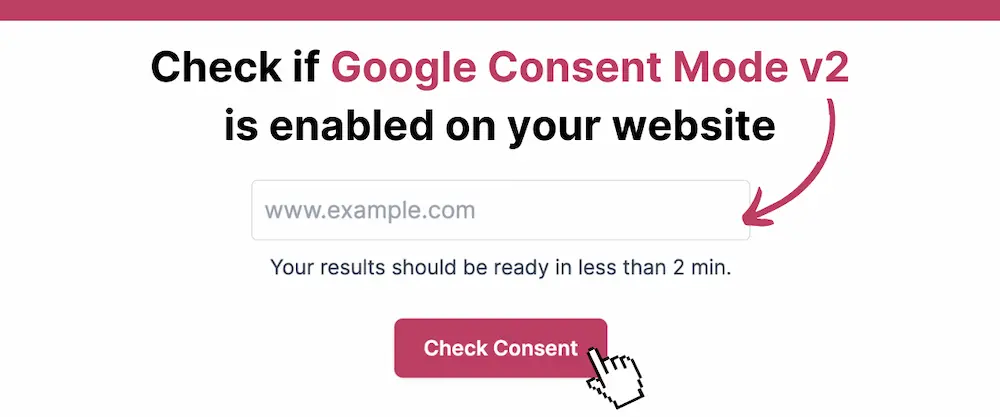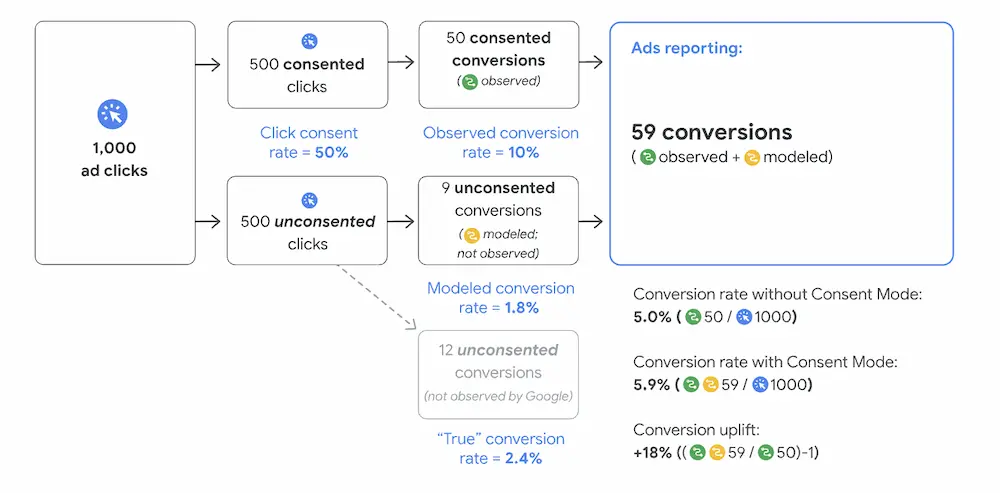Google Consent Mode v2 is a trending topic right now after Google announced that to comply with the Digital Markets Act (DMA), they will be updating how they gather and share the consent of users within their products.
I’ve seen many people speak on this topic on LinkedIn, which seems to be raising confusion about what this change means and what actions must be taken to ensure that Google Ads campaigns and performance are not affected.
At AnyaWay, we’ve made a handy tool called the Google Consent Mode v2 Checker which you can use to quickly check if Consent Mode v2 is enabled on your website.

In this article and the video below, I break down the most common questions I’ve received from my clients so far, and some next steps for your situation and business.
What is Google Consent Mode, and why is there a version 2 now?
Google Consent Mode is an additional way to help send your website visitors’ consent choices to Google products and services.
Consent Mode is made to work together with your Consent Management Platform (CMP), which displays the cookie banner and records the users’ cookie consent choices.
It works by retrieving the consent status based on a user’s choice and communicating this choice to Google’s products such as Google Analytics, Google Ads, Floodlight, and Conversion Linker.
- User Accepts Cookies: Google scripts will be allowed to fire and receive data about this user (and hence connect them to a specific conversion for example).
- User Declines Cookies: Google scripts will not be allowed to fire, therefore not being able to collect the user data*
Google Consent Mode v2 was released in November 2023, and is an update to the first version which has been in “beta” since 2020.
What is the difference between Google Consent Mode v1 and v2?
The two versions of Google Consent Mode are very similar, but v2 has an addition of 2 parameters that help Google stay compliant with the new DMA regulations. These additional parameters are ‘ad_user_data’ and ‘ad_personalization’, which are tied to the already existing ‘ad_storage’ parameter.
The main difference for marketers is that the original Consent Mode was an option for advertisers, but version 2 is a requirement to continue using Google Ads and other products effectively.
It also introduces two methods in which Consent Mode v2 can be implemented: Basic and Advanced.
What is the difference between Basic and Advanced implementation of Consent Mode v2?
The Basic Implementation sounds counter-intuitive because there is more work to do than with the Advanced implementation. In short, the Basic implementation is the restricted version, and the Advanced implementation gives you additional (estimated) data from Google’s modelling algorithm.
The Advanced Implementation works the same way as the original Consent Mode v1, where anonymous pings are still sent to Google, which also gives you access to Google’s advanced modelling features for conversions, remarketing, and lookalike audiences.
To implement the Basic Consent Mode v2 via Google Tag Manager, you need to set up additional consent checks on top of the built-in consent checks already active for Google tags in Google Tag Manager. This ensures that the tags are completely blocked and prevents Google from receiving cookieless pings, or any data at all from that user.
This Google article has a great table which explains the benefits and tradeoffs between the two types of implementation, which you can also see below.

How does modelling work for unconsented conversions in Google Ads?
Google Ads heavily relies on cookies to track conversions and attribute them to specific ad clicks. To help account for conversions of users who did not provide consent, Google has an alternative method, which is called ‘conversion modelling’.
Note: Conversion modelling has already been in place for those who had Google Consent Mode v1 implemented.
Modelling is only activated in the Advanced implementation of Consent Mode v2. If a user declines cookie consent, tags such as Conversion Linker and Google Ads Conversions are usually blocked from being executed. However, with the Advanced implementation, Google still receives user data using “cookieless pings”, and uses that in their algorithm to predict (estimate) unconsented conversions in your Google Ads account.
In theory, this helps fill at least a part of the gaps in conversions, which means there is a general conversion uplift when using the Advanced implementation. The best way to see this is with this visual representation of modelled conversions:

However, this is not always an acceptable choice for businesses because it’s unclear exactly what data is captured in the “cookieless pings”, and whether it’s still possible to identify users with this data. Therefore I would recommend involving the legal team to define the tolerance levels for Basic vs Advanced implementation.
You can learn more in Google’s article about consent mode modeling to help guide your business in this decision.
Need Help Understanding This Topic?
Don't let your questions go unanswered. I'm here to help explain any confusing or unclear parts in the article. Reach out for further explanation or clarification.
What happens if you use Google Ads and don’t implement Google Consent Mode v2 by March 2024?
Without Consent Mode v2, Google is not able to receive the additional parameters needed to ensure compliance. So for advertisers, Google Consent Mode v2 is a requirement, not a suggestion.
It’s unclear the exact actions that Google will take starting in March. However, in the updated EU user consent policy, Google does state quite clearly that they “may limit or suspend your use of the Google product and/or terminate your agreement” if you do not set up Consent Mode v2.
Is Google Analytics 4 (GA4) affected by Google Consent Mode v2?
Yes, Google Analytics is affected if your Google Ads account is connected in the Admin ‘Links’ section of GA4 and you export remarketing audiences or conversions to Google Ads directly.
However, if you do not run Google Ads and only use Google Analytics 4 for website behaviour analytics, there is no urgency to implement Google Consent Mode v2 (yet).
Note that you should still have a cookie consent banner in place if you have EU visitors’ data captured on your website.
What are the next steps if I do not have Google Consent Mode v2 implemented?
First, you should check if your website has Consent Mode v2 enabled using our Google Consent Mode v2 Checker!
Some Consent Management Platforms (CMPs) such as Cookiebot recently updated their scripts to enable Google Consent Mode v2 for all users by default. So if you are using Cookibot for example, and have Google Consent Mode v1, your scripts are automatically updated to the new version and you don’t need to do anything else!
If you find out that Google Consent Mode v2 is not implemented on your website after using the Checker, the implementation depends on which CMP you are using. Some make this transition automatically, but for others, you might need to enable additional settings to enable Google Consent Mode.
Additionally, not all CMPs are compatible with Google Consent Mode v2, and Google has a list of certified partners that they recommend using.
If you do not have a cookie banner or a CMP yet, and you have users from the EU visiting your website, you need to make sure to set up a consent banner.
AnyaWay is a proud certified reseller and partner of Cookiebot CMP. If you would like to receive a 15% discount on any Cookiebot plan, please submit a contact form with the request and we will send you personal invite with the discount to your email.

Anya Avdeeva
As a dedicated Marketing Ops and Analytics expert, Anya is deftly navigating the digital world and using her insights to close the digital analytics knowledge gap with her work and content.
AnyaWay Blog in a Monthly Newsletter
- Delivered once a month
- Packed with insights
- Unsubscribe any time